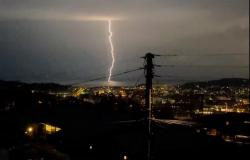Online to the point These are comments written by Nettavisen’s editor-in-chief.
The decision to use NOK 23 billion from the state to get the Sørlige Nordsjø II offshore wind farm up and running has made some dream of cheaper electricity prices.
You just have to forget:
- Southern Norway is getting less and less surplus power (which is exported), and the offshore wind will not arrive until after 2030.
- Even with seven billion kilowatt-hours from Sørlige Nordsjø II, price area N02 will have less power to spare when the time comes.
- NVE predicts electricity prices of over 80 øre per kilowatt hour in the next six years. The main reason is less power surplus and the cables to foreign countries.
Here you can read NVE’s analysis: Long-term power market analysis 2023
Havvind makes a small contribution
Just before Easter, the Arendals company Volt Power Analytics sent out a press release which many media reproduced as if offshore wind would give us lower electricity prices.
It is a misunderstanding. We do not get lower electricity prices at all, but we do get lower electricity prices than we would have had without offshore wind.
The analysis shows that offshore wind – seen in isolation – contributes to to make the electricity price 6–10 øre per kilowatt hour cheaper than it would otherwise beand that nothing happens until 2031 – that is, seven years from now.
Volt’s managing director Kathinka Bogaard responds as follows to questions about how much uncertainty they have in the price estimates:
– This is a sensitivity analysis that we have carried out based on our “best guess” of the power market many years into the future. There is room for an infinite number of changes on the way to 2030, but we have given an indication of how the electricity price will be affected by Sørlige North Sea II based on the information we have here and now in 2024, Kathinka Bogaard replies in an email.
– Is it correctly understood that Sørlige Nordsjø II (SNII) – all other things being equal – will contribute minus 10 øre/kWh?
– That is correct. By “all other things being equal”, it means equal assumptions about development in industry, electrification, access to other power generation, etc.
Does not fall so much in practice
– Is it correctly understood that SNII will cover 7 out of 10 TWh in increased consumption until 2030, so that the power balance will be somewhat weaker then than now? In that case; can we count on increased prices all in all, or is there something else that explains the price drop?
– SNII will only produce electricity after 2030. When it first produces electricity, it will improve the power balance by approx. 7 TWh given that there will be no new industry / other power-intensive consumption. Some of the price effect will be dampened by the establishment of new industry due to the power surplus, says Volt leader Kathinka Bogaard to KRS.
Robert Hjorth, who leads the Boston Consulting Group’s offshore wind work in the Nordics, does not believe that electricity prices will fall that much in practice. – Lower electricity prices will increase demand. New industry, such as data centers for artificial intelligence, can cause electricity consumption to be higher than expected and that the price impact from Sørlige Nordsjø II will consequently be dampened, he says in the press release.
Expensive electricity here to stay
Figures from NordPool show that southerners have paid much more for electricity so far this year than was usual just a few years ago. Mostly, the price has been around a rent where consumers have to pay the maximum without reaching electricity support.
The cabin people don’t get five cents in electricity support, so those who now heat the Easter cabins have to pay the whole bill themselves.
For homes, the electricity subsidy covers 90% of the electricity price above 91.25 øre/kilowatt hour. It is worth noting that VAT to the state is included. Before VAT the support is 90% of what goes over 73 øre/kilowatt hour.
No power support today
With today’s electricity price of 75 øre per kilowatt hour for the electricity itself, there will be no electricity subsidy to speak of. On top of that are line rental, value added tax, electricity tax and surcharges for the electricity supplier.
Normally, a consumer would pay NOK 1.40 per kilowatt-hour today, all included, according to the electricity calculator at MinSpotpris.
Who takes most of the winnings? The answer is the state, which all in all takes up to 67 percent of the electricity price in various taxes and fees.
Expensive electricity has become a milk cow for the state treasury, and it does not help much for the individual consumer that the state spends NOK 23 billion subsidizing offshore wind production in the Southern North Sea II when at the same time promising away electricity to battery factories and data centers.
If NVE is right, prices will remain high until 2030, partly because of Google’s data center in Skien (100 employees need two billion kilowatt hours (TWh annually)) and Morrow’s battery factory in Arendal (2.6 billion kilowatt hours or 2.6 TWh ).
Otherwise, the losers will be the business world
Even if Volt is right that offshore wind will make prices lower than they would otherwise be (which is likely since we are talking about 7 TWh), it is far ahead, uncertain and trivial for the average consumer.
What seems certain is that everyone with a cabin will have to count on continued high electricity prices for many, many years to come. And the same applies to the part of business that is not data centers or battery factories, and that does not come under any support scheme for companies.
A few years ago, it was normal for electricity prices to drop to 20 øre per kilowatt hour.
Now the companies have to pay four or five times more for electricity for a number of years to come.
Tags: Sea wind Southern North Sea Expensive electricity cabin worse coming years
-




